Who Is Olivia Smith?
Olivia Smith is a 19-year-old Canadian forward currently playing for Sporting Lisbon in Portugal.
She is certainly a name that will be on a number of teams’ wish lists for this summer’s transfer window, having already garnered interest from WSL clubs Liverpool and Arsenal.
Smith is a talent people have known about for a while, having made her debut for the Canadian national team at just 15 years of age in 2019.
However, this has been somewhat of a breakout season for the youngster.
Smith joined Sporting for the 2023/24 season, previously enrolled at Penn State in the US College soccer system, and this season played a major role as Sporting narrowly missed out on the title to Benfica.
This tactical analysis will provide an analysis of why the top clubs should be looking at Smith this summer.
This Olivia Smith scout report will outline the key statistics and tactics that make her one of the most exciting prospects in world football.
Olivia Smith Chance Creation
One of the areas in which Olivia Smith excels is in her ability to create goalscoring opportunities both for herself and for her teammates.
Let’s now analyse the statistics that can help illustrate this point.
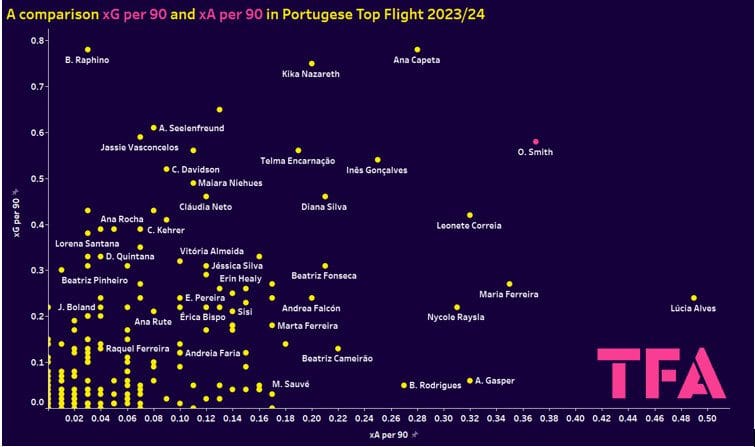
This first graph compares xG and xA per 90 across the Campeonato Nacional Feminino this season.
The implication is that a player producing a higher number of goalscoring opportunities would score high in both categories.
As you can see, Smith is one of the leading performers in both categories.
Her xG per 90 of 0.58 makes her the seventh-best performer in the division; interestingly, she is the highest performer of the non-strikers.
In addition to being a high performer in xG, she is also a leading performer in xA, with her average xA per 90 of 0.37 being the second highest, only bettered by Benfica’s Lucia Alves.
It is clear that Smith has been a top chance creator throughout the 2023/24 campaign.
However, let’s break down the type of chances she is creating to get a better idea of her style of player.
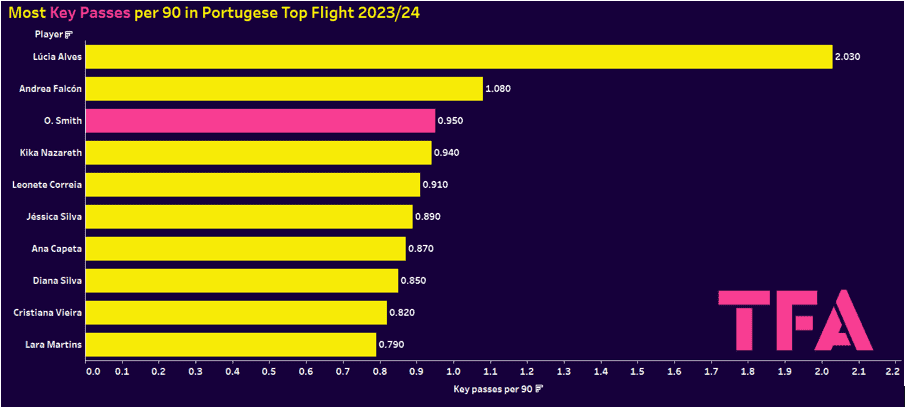
This graph above shows how Smith completes the third most key passes per 90 of any player in the division, with Smith’s average of 0.95 key passes per 90 only being bettered by Benfica’s wingbacks in Alves and Andrea Falcon.
However, this is not the only statistical area that Smith thrives in.
Smith is also the thirteenth best performer in the division in terms of passes in the box per 90 with 3.52, and she has an accuracy rate of 46.15%, which is impressive considering that the passing windows are generally going to be smaller in this area of the field as opposition teams protect their goal.


In this situation, Smith finds herself in a one-on-one situation with the Benfica left-back out wide.
Smith is able to beat her opponent and drive forward in attack, which draws the attention of Benfica’s central defender, Christy Ucheibe.
However, as Ucheibe is drawn into Smith, Smith launches an excellently weighted through ball between Ucheibe’s legs towards teammate Brittany Raphino, who has made a run in behind the Benfica defence, one-on-one with the goalkeeper.

In this example, Smith receives the ball in her own half.
Her first thought is to look forward and try to be positive about the ball.
Here, she is able to see the run being made by her centre forward, Raphino.
What is most impressive about these examples is not only her positivity and confidence in playing the cutthroat passes to teammates but also her understanding of teammates’ movements.
Where she is able to understand what her teammates are going to do and where they are going to be before they are.
As a result, they are able to predict events and, therefore, execute these actions before opposition defenders can react.
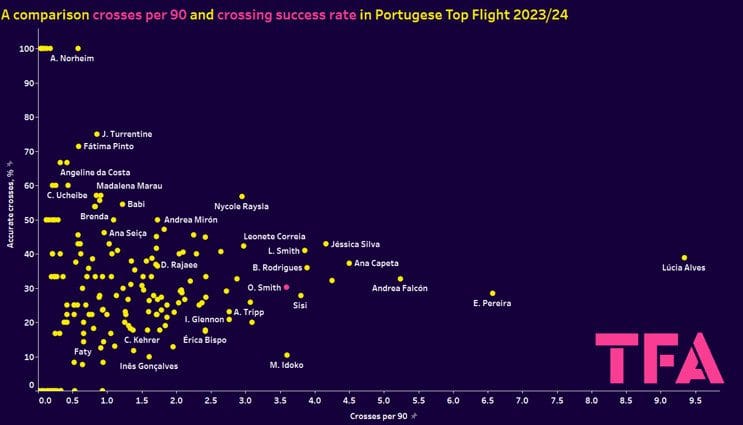
However, Smith is not just a leading performer in her passing; her crossing is also a strong weapon in her arsenal.
She completed the eleventh most crosses per 90 in the division, with 3.59, at a success rate of 30.19%.

This example just goes to show the quality that Smith possesses from wide positions.
In a deep position, she identifies the run towards the back post by teammate Leonete Correira.
Smith’s delivery then puts Correira in an excellent goalscoring position in the box to header it in; however, she is unable to convert on this occasion.
Smith can vary the type of her delivery as well, with the previous example showing a deep lofted cross, which makes her so effective when it comes to taking set-pieces.
However, she has also demonstrated the ability to cross with the outside of her right foot using her left foot, which enables her to be effective from different angles.
Additionally, she can vary the height and style of delivery to suit the situation.

In this example, Smith has made a run in behind the opposition defence.
As a result, Albergaria is behind the ball and can’t obstruct its path.
So Smith plays a low, whipped cross into the path of Correira, who is unable to convert from close range.
Olivia Smith Scoring Goals
Another area that Olivia Smith is particularly strong in is her ability to be effective in front of goal.
Let’s now look at a number of statistical areas that demonstrate this point.
This graph demonstrates the efficiency and effectiveness in front of the goal.
We chose to use non-penalty goals instead of all goals, as penalties can skew the data, and we want to find out the effectiveness of Smith in open play.
This graph clearly demonstrates that Smith is performing well in both categories, which is important as it shows that she is not wasteful in front of goal.
Instead, it actually shows that she is outperforming her xG.
Her xG per 90 is 0.58, while her average for non-penalty goals per 90 is 0.88.
Over the season, this equates to Smith exceeding her xG by around 4.4 goals.
One of the reasons that Smith is so effective at scoring goals is her ability to get into goalscoring positions around the box.
In terms of touches inside the box, she is the fourth-best performer in the division, averaging 6.44 touches in the box per 90.
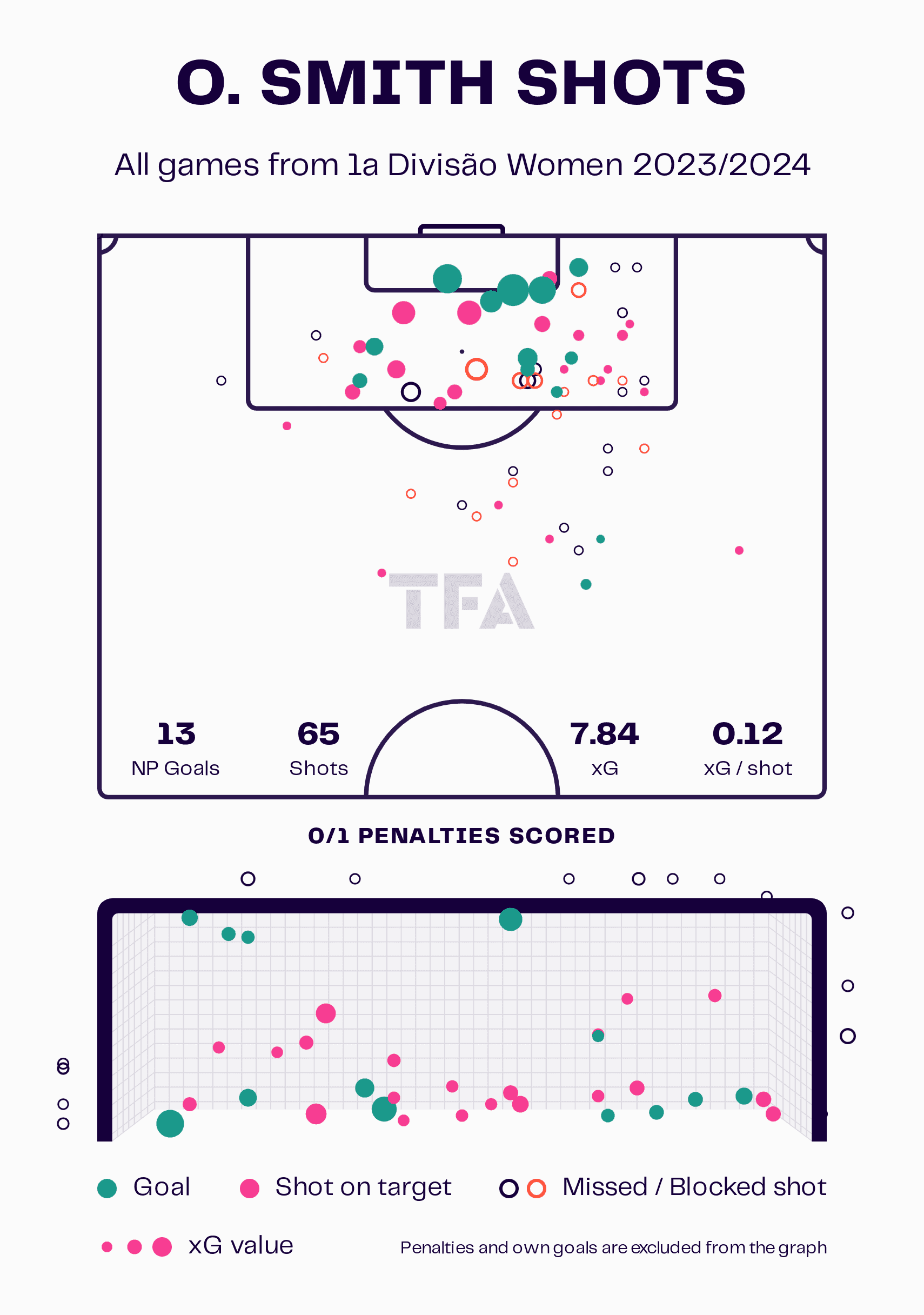
As this graphic demonstrates, most of her shots are in high xG positions inside the box, with the average xG per shot being 0.12.
This means that she is getting in the right position on a regular basis, which is only going to bode well moving forward.
Let’s take a look at how Smith is effective at scoring goals.
Smith’s ability to score goals consistently stems from movement off the ball.
She looks to get in behind the opposition and, as a result, is able to regularly find herself one-on-one with the goalkeeper.
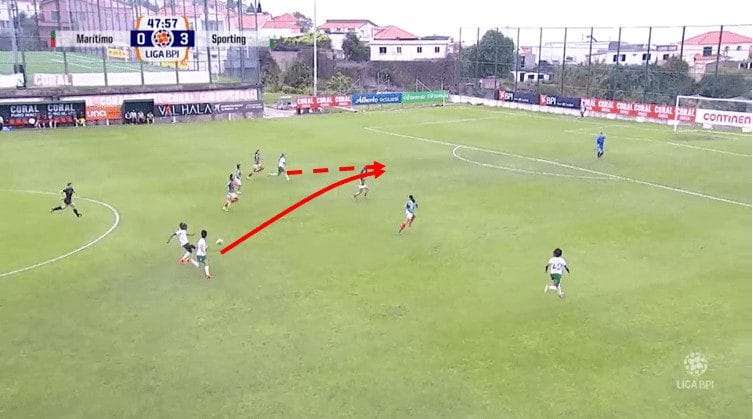
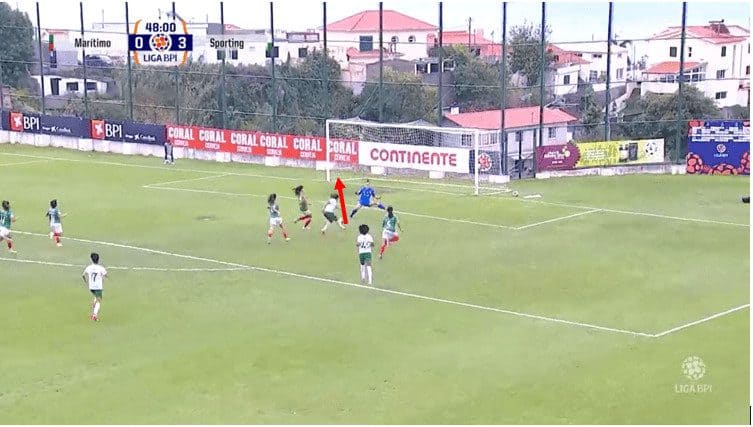
Here, Smith makes an outside run from the left wing and is able to get in behind the Maritimo defence.
Smith takes one touch to get the ball out of her feet before finishing off one-on-one with the goalkeeper.
Not only does Smith possess excellent speed, but she is also quick to identify and attack, demonstrating excellent quick thinking on a number of occasions in order to find herself in a dangerous position.
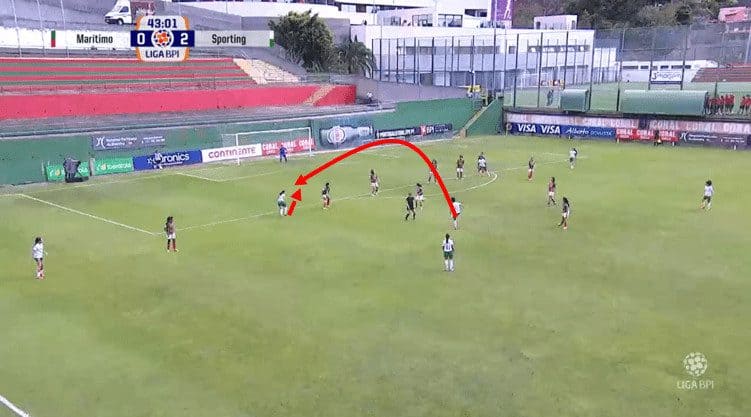

In this example, Sporting has a drop ball.
Smith sees the opportunity to run in behind the defence, where she controls it with her chest before volleying home with her right foot.
Having demonstrated Smith’s ability to consistently find herself in excellent goal-scoring positions.
Smith also combines her positioning with excellent technical proficiency, where she can strike the ball with power using her left foot and right foot.
Additionally, she can convert long-range shots, volleys and close-range shots in the box, making an incredibly dangerous proposition for any opposition to deal with.


Here, Sporting plays a long ball to Smith in space out wide.
Smith controls the ball with her head before firing a left-footed volley into the bottom corner to seal the game against the premium side in Portugal this season.
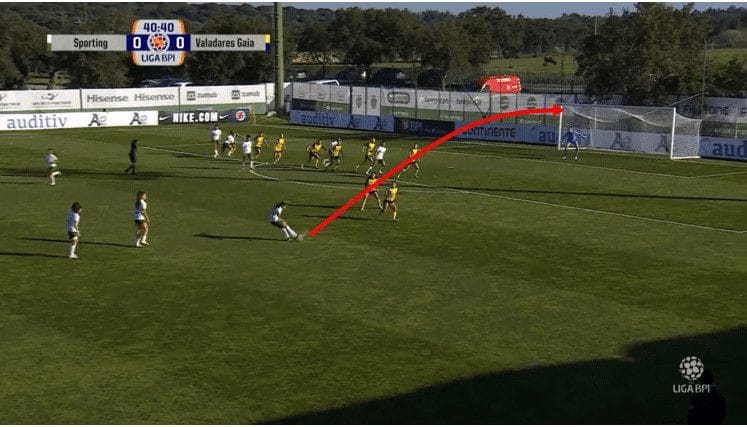
This example here against Valadares Sporting takes a short freekick which changes the point of attack for Smith.
The pass rolls into Smith’s path, and she fires a long-range shot that fires into the top corner of the net.
Olivia Smith Dribbling
Having looked at how Olivia Smith can be effective in terms of end product and be an important part of the team.
Let’s now take a look at Smith’s ability on the ball, which enables her to reframe the situation to suit herself and create the best out of the situations.
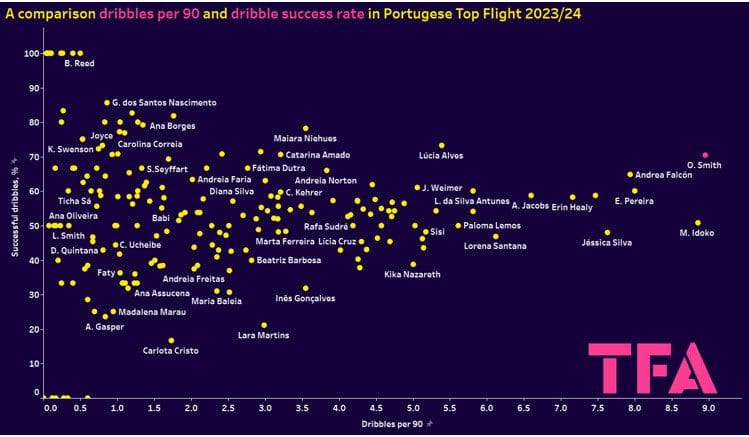
This illustration demonstrates how efficient Smith is at completing dribbles.
Dribbles per 90 indicate the body of work she is getting done in a match, while the dribble success rate establishes how wasteful, in Smith’s case, she is when dribbling.
As we just alluded to, the graph here demonstrates that not only is she completing a high volume of dribbles, averaging 8.95 dribbles per 90, but she is also completing these at a high success rate of 70.45%.
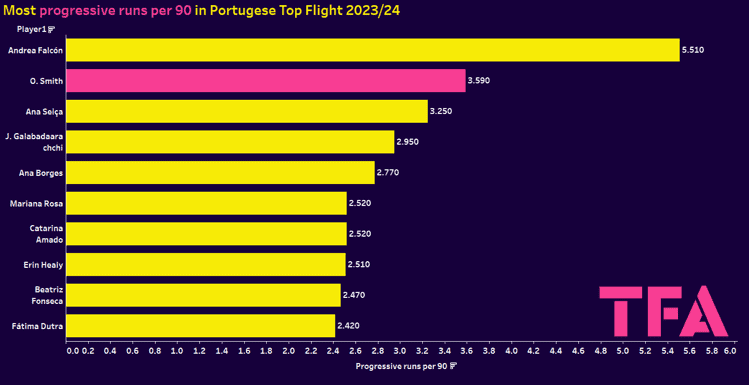
In addition to being an excellent dribbler, Smith’s ability on the ball also translates to a high volume of progressive runs per 90.
With Smith averaging 3.59 progressive runs per 90.
This enables her to help carry Lisbon forward in attack.
What is most significant about Smith’s ability to be an effective dribbler is not the fact that she can win one-on-one matchups but what this enables her to do as a result.
It enables her to change the picture to suit her side.
Now, we will look at a few examples of this in practice.


This example comes from the CONCACAF Gold Cup, where Smith played for Canada.
Smith receives the ball with her back to goal in the midfield.
She is then able to turn and accelerate, driving the team forward in attack, taking the Paraguay midfield out of the game.
Additionally, it opens up the right side of the field and creates new passing lanes for Smith to exploit.

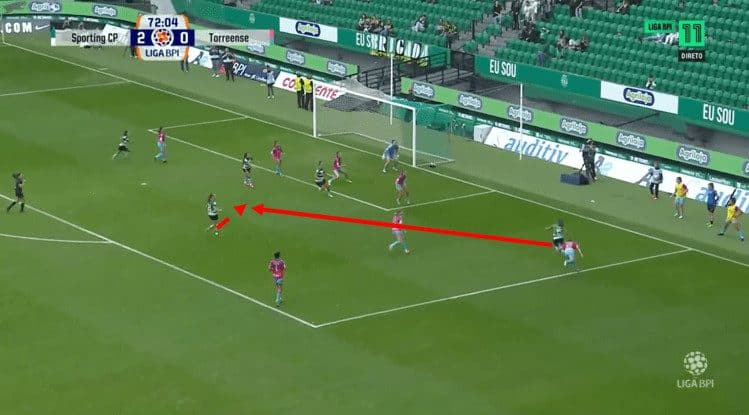
Here is a good example of why Smith’s ability to beat opponents is vital to her ability to create goal-scoring chances.
Here, she can take on and beat the Torreense fullback on the outside, following some nice footwork to slow her opponent down before exploding down the line, leaving her opponent in her wake.
Having beaten her opponent, she has now created time and space for herself and can, as such, pick out a teammate in the box.
This time, she opts to play a cutback cross to Maiara Niehues, who is unable to convert on this occasion.
Olivia Smith Defending
Having primarily looked at Smith’s ability in the attacking phase.
Let’s now turn our attention to Smith on the defensive side of the ball and see how her contribution could be effective at the next level.
Although not necessarily Smith’s best asset, she is very capable of contributing to this side of the ball.
She has averaged 5.9 defensive duels at a success rate of 74.71%.
In addition to this, she has averaged 3.94 PAdj(Possession adjusted) interceptions per 90.
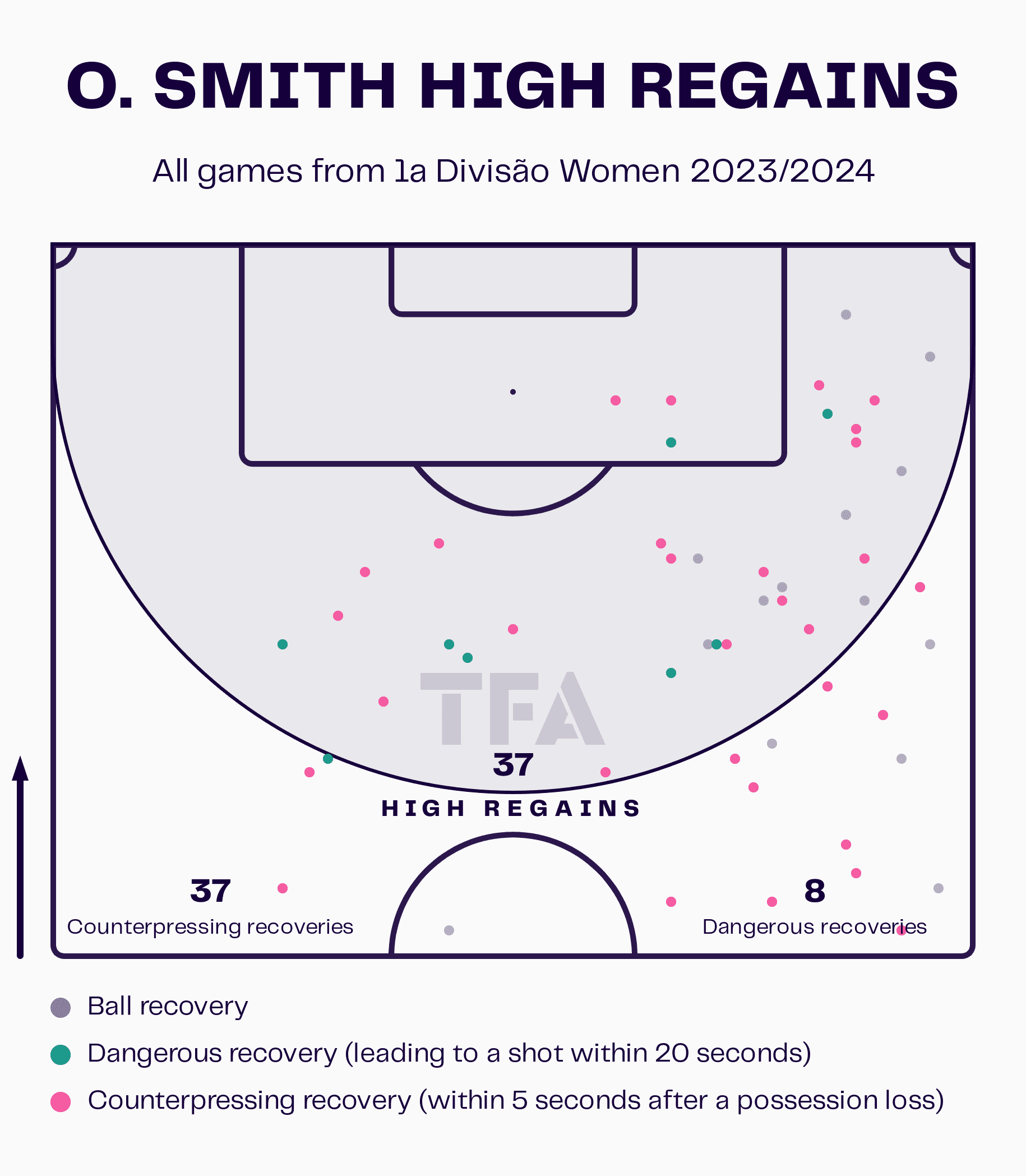
However, perhaps most intriguingly for interested pursuers, Smith has demonstrated the ability to win the ball high up the field in dangerous goalscoring positions, as demonstrated by the 37 high regains she has made this season.
In addition to this, she has averaged 3.93 regains in the opponent’s half per 90.
This could make her a vital piece for a side that wants to play a high defensive engagement line where they want their forwards to make a contribution on the defensive side of the ball.

This example here illustrates how Smith can be used effectively in high-pressing situations.
With Ucheibe backtracking to pick up a loose ball.
Smith puts on physical pressure from behind.
Although initially, Smith’s eagerness enables Ucheibe to roll her Smith.
Smith’s grit and determination to work back enables her to force Ucheibe onto her left foot and put pressure on the exit pass by Ucheibe.
Conclusion
As you can see, despite still being a teenager, Olivia Smith has taken the Portuguese top flight, Campeonato Nacional Feminino, by storm.
In her short time, she has established herself as a talented winger who can provide goals and assists to her side.
She has also earned international recognition with the Canadian national side.
So, it’s no wonder that a number of WSL clubs are interested in acquiring her services for the upcoming season, establishing herself as one of the brightest prospects in women’s football.
Either way, this summer could be an interesting one to keep an eye on for Smith.






Comments